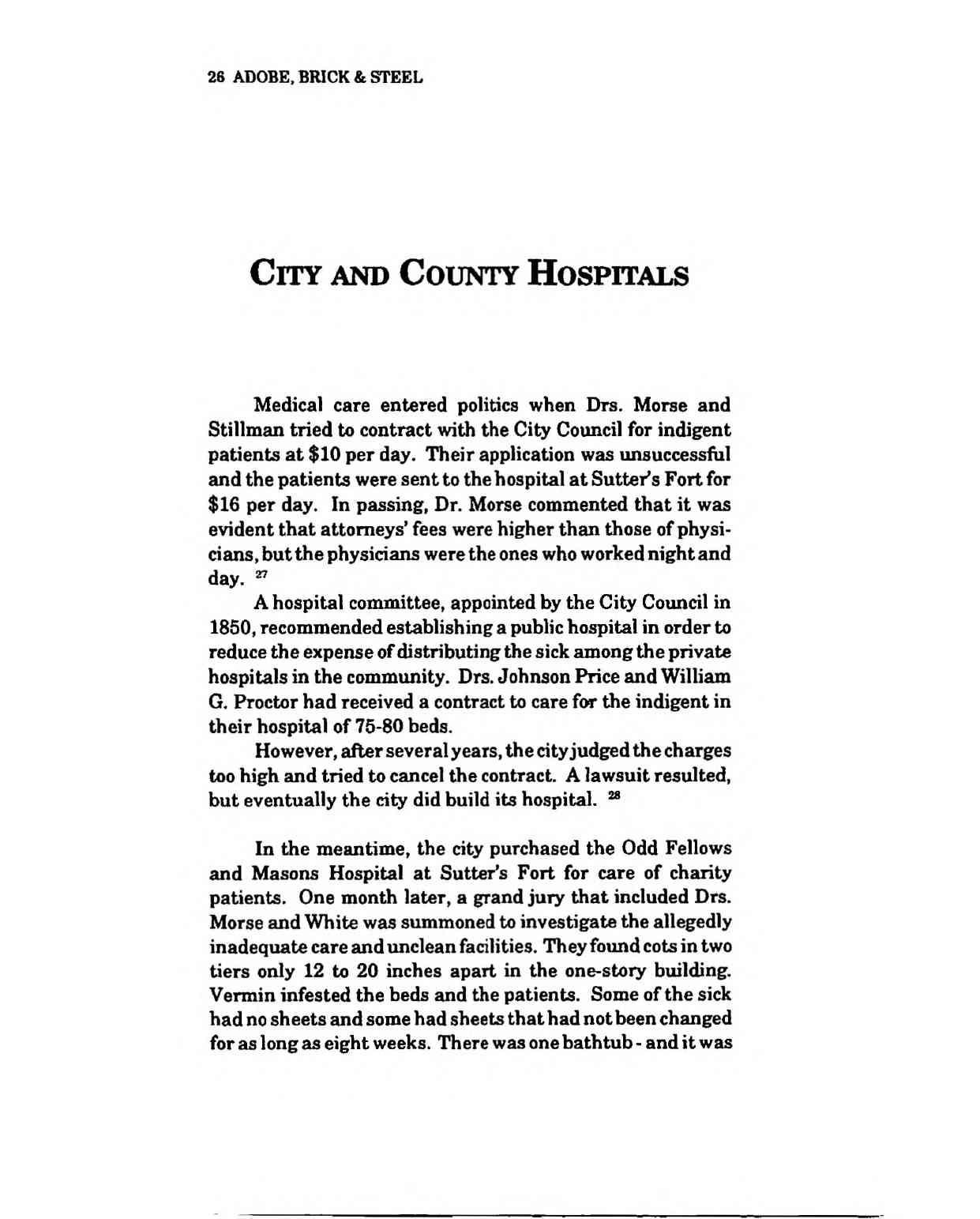
5 minute read
City and County Hospitals
Medical care entered politics when Drs. Morse and Stillman tried to contract with the City Council for indigent patients at $10 per day. Their application was unsuccessful andthepatients were sentto thehospital atSutter's Fortfor $16 per day. In passing, Dr. Morse commented thatit was evident that attorneys’ fees were higherthan those ofphysicians,butthephysicians weretheones whoworkednightand day. 27
Ahospital committee, appointed by the City Council in 1850, recommendedestablishingapublic hospital in orderto reduce theexpenseofdistributingthesick amongtheprivate hospitals in the community. Drs. Johnson Price andWilliam G. Proctor had received a contract to care for the indigent in their hospital of75-80 beds.
However,afterseveralyears,thecityjudgedthecharges too high and tried to cancel the contract. A lawsuitresulted, but eventually the city did build its hospital. 28
In the meantime, the city purchased the Odd Fellows and Masons Hospital at Sutter’s Fort for care of charity patients. One month later, a grand jury that included Drs. Morse andWhite was summoned to investigate the allegedly inadequatecareanduncleanfacilities. Theyfoundcotsintwo tiers only 12 to 20 inches apart in the one-story building. Vermin infested the beds and the patients. Some ofthe sick hadnosheetsandsomehadsheetsthathadnotbeenchanged foraslongas eightweeks. Therewasonebathtub - anditwas
used for feeding horses. Most ofthe patients suffered from dysentery and there were flies everywhere. 29
Improvementaftertheinvestigation was evidentlyslow because, in November 1854, a reporter for the Sacramento Union, writing underthe name “Pipes,” described a sighthe would never forget: “thirty beds crowded together, generalized moaning, andaman who lookedathim pleadingly while dying oftyphoid.” 30
The first Sacramento City Hospital had been partially assembled, in 1850, in theblock bounded by 9th and 10th, I and J Streets, at a cost of$14,000, when the structure was blown down in a storm. The City Council was determined to establish an institution that would belong to both city and county, so efforts continued along that line. In 1853, a city hospital wasbuiltandremainedforadozenyears at 10thand L Streets, a site which later became the northwestcomer of Capitol Park. Records show that, in 1858, the physician in charge received $150 a month not only for his own subsis-
Sacramento County Hospital, 1879, “History of Sacramento CountyThompson and West. Drawing by John Howell.

tence,apparently,butalsotofurnish“allthenecessarydrugs, medicines, medical appliances to the medical departmentas now or hereafter may be required.” 36
Inthelate 1860s,theCountyboughtasixty-acretracton Stockton Boulevard, three miles from the city center, for $11,000. By 1870, an $80,000hospital wasconstructed here, offering 216 beds and many amenities appropriate to the times. There was an administration building with 2 threestory wings. Butitwas wiped outby fire on October5,1878, andthepatients wereplacedin emergency quartersindowntown Sacramento at the Agricultural Pavilion at 6th and M Streets.
With commendable dispatch, a new Sacramento City andCountyHospital wasbuiltontheStocktonBoulevardsite and putin service in 1879. It was designed by N.D. Goodel!, who also designed the Governor’s Mansion at 16th and I Streets, to consist ofa two-story main administration buildingwith 5 wings and accommodations for 150-160beds. The costwas $65,000.
Sacramento County Hospital with horsedrawn ambulance at entrance in 1879. Photo courtesy Dr. J.B. Harris collection.

Objections had been raised concerning the Stockton Boulevard location. The Sacramento Society for Medical Improvementwrotethattheplace was“desirableforanAlms House, butfor the purposes ofthe City and County Hospital the wholeinstitutionis awillfulblunder.”37 Surroundingthe hospital were 4 acres ofvineyards, 5 or 6 of gardens, 10 of pasture,andthe remainderconsistedoforchards. Inkeeping with the times, the hospital had an ambulance, a one-horse wagon which wentintothecityonce adayforsupplies and to transport patients, doctors and employees.
Making the most ofsite advantages, the strongest patients wererequiredto careforthegrounds,raisevegetables, and act asjanitors. Further:
“Apatienttobeadmittedintothisinstitutionmust presentacertificateofhis residenceforthirtydays in this County; that he is destitute and has no means with which toprovidehimselfwith medical treatment — which certificate must be signed by two respectable and known parties, who are personally cognizant ofthefacts.”38

0
.r?„ a..
n> ? SSj 5 i 1 y||I[ 5|,
siHa
Sacramento County Hospital, 1930. Photo courtesy Dr. Dan Treat.
Dr. George Amos White, as County Physician, was in charge of the hospital, a position he occupied from 1872 to 1904, exceptforan interim, 1879-81,whenhewasreplacedby a homeopathic doctor. Bom in Missouri, White had graduatedfromLongIslandMedical College in NewYork, in 1868, and Jefferson Medical College at Philadelphia, in 1869. He came to Californiato practice in Davis and Sacramento, and gained distinction for his great skill in surgery. He also initiated the use ofspinal anesthesia here, brought in one of thefirstX-ray machines, andhelpeddevelop thefirstclinical laboratory.
Alldidnotrunsmoothlyforthecountyhospital. In 1908, the city Board ofHealth and the press complained about its unsanitary condition. The SocietyforMedical Improvement investigatedandrecommendedtheappointmentofaresident administrativeofficeras wellasvolunteervisitingphysicians and surgeons to staffthe various departments.
In 1915, expansionbeganagain on Stockton Boulevard. Anurses'homeandanagedwomen'shomewereadded. Total beds now numbered 500.
Sacramento County Hospital, early entrance as shown on a postcard.

The nationwide influenza epidemic of 1918-19 hit the Central Valley hard and produced many patients for the County Hospital. In one two-week period, there were 2,500 victims in Sacramento ofwhom 300 died. By the end ofthe epidemic, out ofa population of70,000, some 5,000 had been affected and 500 had died.
Additions and improvements continued over the years, so thatthe finished cost ofthehospital reached $1 million in 1929. A full-time resident superintendent was in charge, beginning in 1918. In December 1932, the patient load was relieved somewhat upon completion ofa home for aged men, seven miles south, on Franklin Boulevard atFlorin Road.
Under the superintendency of Dr. Leo Farrell, in the fiscal year 1944-45, the “wonder drug* penicillin was introduced for the firsttime. Reflectinga core Sacramento population of219,000, with a much larger outlying service area, there were 110,831 outpatients treated at County Hospital, and80,424custodialpatients. Thehospitalalsoservedasthe polio center for Northern California.
A six-story medical center was built in 1950, increasing thebedcapacityto800. Volunteerphysiciansstillheadedthe various departments, andinterns andresidents continued to be accepted for training.
The next decade witnessed the start ofa $10.5 million modernization program, and the County Hospital became a community medical center, open to all in the Sacramento Valley. The main plant was remodeled and an eight-story wing was added.











